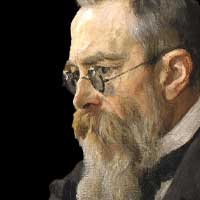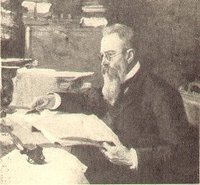Nikolai Rimsky-Korsakov - Biography
Nikolai Rimsky-Korsakov Biography
Nikolay Andreyevich Rimsky-Korsakov (Russian: Никола́й Андре́евич Ри́мский-Ко́рсаков), also Nikolai, Nicolai, and Rimsky-Korsakoff, (March 18, 1844 – June 21, 1908) was a Russian composer and teacher of classical music particularly noted for his fine orchestration, which may have been influenced by his synaesthesia. His most famous composition is The Flight of the Bumblebee.
Born at Tikhvin, near Novgorod, into an aristocratic family, Rimsky-Korsakov showed musical ability from an early age, but studied at the Russian Imperial Naval College in Saint Petersburg and subsequently joined the Russian Navy. It was only when he met Mily Balakirev that he began to concentrate more seriously on music. Balakirev encouraged him to compose and taught him when he was not at sea. He also met the other composers of the group that were to become known as 'The Five', or 'The Mighty Handful', through Balakirev. While in the navy, Rimsky-Korsakov completed a symphony, the first such piece to be composed by a Russian. He also completed his well known orchestral piece Sadko (1867) and the opera The Maid of Pskov (1872), before resigning his commission in 1873.
Rimsky-Korsakov and the other members of 'The Five' frequently collaborated on or edited each other's compositions. In particular, after the death of Modest Mussorgsky in 1881, Rimsky-Korsakov took on the task of revising several of Mussorgsky's pieces for publication and performance. For example, Rimsky-Korsakov's arrangement of Mussorgsky's Night on Bald Mountain is the version generally performed today. However, critical opinion of Mussorgsky has changed over time so that his style, once considered unpolished, is now valued for its originality. This has caused some of Rimsky-Korsakov's other revisions, such as that of Boris Godunov, to fall out of favor and be replaced by productions more faithful to Mussorgsky's original manuscripts.
In 1871, despite being largely self-taught, Rimsky-Korsakov became professor of composition and orchestration at the Saint Petersburg Conservatoire. There he taught many composers who would later find fame, including Alexander Glazunov, Sergei Prokofiev and Igor Stravinsky. He continued to be a prolific composer, producing many orchestral works, including the well known Sheherazade and Capriccio espagnol. He also wrote fifteen operas, including The Immortal Koschei and The Tale of Tsar Saltan, the latter of which includes his most famous piece, The Flight of the Bumblebee, since arranged for all kinds of different instrumental groups. Among his Russian Orthodox liturgical music is the a cappella Liturgy of St. John Chrysostom.
In 1905 Rimsky-Korsakov was fired from his professorship in Saint Petersburg owing to his expressing some political views the authorities disapproved of. This sparked a series of resignations by his fellow faculty members, and he was eventually reinstated. The political controversy continued with his opera Le Coq d'Or (The Golden Cockerel) (1907) which was an attack on Imperial Russia, and which was banned from performance following its premiere.
Towards the end of his life, Rimsky-Korsakov suffered from angina. He died in Lyubensk in 1908, and was interred in Tikhvin Cemetery at the Alexander Nevsky Monastery in St. Petersburg. His nephew Georgy Mikhaylovich Rimsky-Korsakov was also a composer.
This biography is published under the GNU Licence

